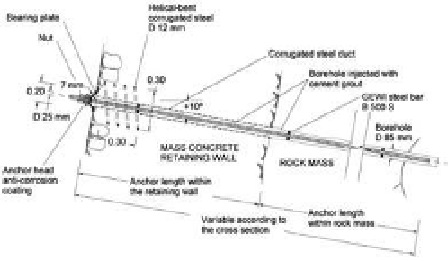Environmental Engineering Reference
In-Depth Information
more modern rock nailing technologies, has been
suggested.
This structural solution aims the combination
of the highly-experienced local stonework con-
struction procedures, traditionally utilized in the
canaries (especially masonry retaining walls),
with a reinforcement consisting of passive steel
bar anchorages, allowing an important reduction
of wall foundation surface and achieving the mini-
mum impact on landscape.
Unitary construction cost of the proposed slope
stabilization structural system was assessed around
126 €/m
2
slope surface, including health and safety
at work measures. Based on this result, it is con-
cluded that the required investment expenditure
is notably lower with respect to other possible
structural solutions. The working period of time,
for a road section of 340 m long, can be estimated
around 2 months.
Figure 5. Passive fully grouted permanent mono-bar
anchor inserted in a pre-drilled (in rock mass) and pre-
cast (in mass concrete, using corrugated steel ducts)
borehole.
is pressure fully-grouted after the insertion of each
bar, employing a ceM i 42.5R cement laitance.
The anchor category as a function of its design life,
social and economical allowable risk if failure, and
injection system result to be: category c5 (ache
2005), type 7 (DGc 2003b).
optimum spacing between anchor heads and
dip angle has been calculated, depending on the
main joint set dip angle and joint friction, though
within some practical construction limits.
Bar lengths and diameters were designed by ana-
lysing the individual performance of each anchor,
checking the design steel tensile strength and
the safety against pulling out (both with respect
to grout-steel bar failure and grout-rock mass
failure).
some recommendations related to ultimate
shear strength for ground anchorages, which can
be consulted in littlejohn (1995) and in the afore-
mentioned spanish standards (DGc 2003b), and
our own experiences with volcanic massive rocks
were applied for mechanical design. The section of
the bars was standardized to 25 mm for simplify-
ing, and anchorage total lengths of 3.0, 3.5 and
4.0 m have been calculated.
ReFeRences
asociación científico-técnica del hormigón estruc-
tural ache. 2005.
Recomendaciones para el proyecto,
construcción y control de anclajes al terreno.
3th ed.
Madrid: colegio de ingenieros de caminos, canales
y Puertos.
Barton, n & choubey, V. 1977. The shear strength of rock
joints in theory and practice.
Rock Mechanics
10 (1).
comisión Permanente del hormigón. 2008.
Instrucción
de Hormigón estructural.
ehe-08. Madrid: Ministerio
de Fomento, secretaría General Técnica.
corominas, J. 2004. Tipos de roturas en laderas y taludes.
in lópez Jimeno, c.
et al
. (eds),
Ingeoter 4
: 191-213.
Madrid: U.D. Proyectos, e.T.s.i. Minas, UPM.
Franklin, J.a. & senior, s.a. 1997. The ontario Rockfall
hazard Rating system.
Engineering Geology and Envi-
ronment
. Rotterdam: Balkema.
González de Vallejo, l.i., hijazo, T., Ferrer, M. &
seisdedos, J. 2007. Geomechanical characterization of
volcanic materials in Tenerife. in Malheiro & nunes
(eds.),
Volcanic Rocks
. london: Taylor & Francis
Group.
hadjigeorgiou, J. & scoble, M. 1990. Ground charac-
terization for assessment of case of excavation.
Mine
planning and equipment selection
. calgary.
hoek, e. & Brown, T. 1980. empirical strength crite-
rion for rock masses.
J. Geotech. Eng. Div., ASCE
106
(GT9): 1013-1035.
international society of Rock Mechanics isRM. 1981.
Suggested methods for rock characterization, testing
and monitoring
. oxford: e.T. Brown. Pergamon Press.
kilic, R. 1999. The Unified alteration index (Uai)
for Mafic rocks.
Environ. Eng. Geosci., AEG
(4):
475-483.
littlejohn, s. 1995. Rock anchorages.
News Journal.
International Society for Rock Mechanics
2 (3,4).
Ministerio de Fomento. Dirección General de carreteras
DGc. 1998.
Instrucción sobre las acciones a considerar
4
conclUsions
Due to environmental, economical and building
reasons, solutions involving complex and high-
priced cantilever structures, in order to provide the
requested widening of the roadbed infrastructure,
had to be discarded.
Therefore, a combined structural system for
rock slope stabilization, that integrates numerous
reinforcement measures joining together tradi-
tional retaining wall construction techniques and















